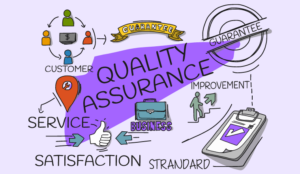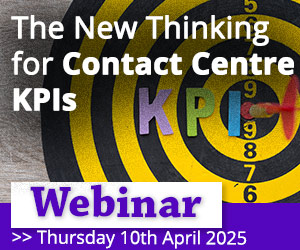Call centre agents have incredibly busy workdays. In fact, one agent can easily take up to 50 calls a day. Since 90% of customers prefer to speak with a live agent over sending an email or text message, agents are constantly interacting with new and potential customers with a range of needs.
With such an influx of calls and communication, how can call centre managers ensure each of their agents is upholding an excellent level of service? A call centre quality assurance program is key to providing a better experience to employees and customers alike.
Why Is QA Important in Call Centres?
Quality assurance is the data that a company uses to measure performance. This data is important because it gives call centre teams the tools to not only improve their performance, but also improve the customer journey from start to finish.
Each industry has its own ways of determining customer satisfaction, but there are common elements to all. Some of the most common QA metrics include Average Handling Time (AHT), Customer Satisfaction Score (CSAT), and Net Promoter Score (NPS.)
What Is Average Handling Time (AHT)?
This is the average amount of time an agent spends resolving customer issues. Average Handling Time measures all channels of communication (like email messages and text bots) from start to finish. AHT includes holds and follow-ups.
What Is a Customer Satisfaction Score (CSAT)?
A Customer Satisfaction Score is the numerical scoring of a customer’s experience with a call centre agent or agency.
What Is a Net Promoter Score (NPS)?
A Net Promoter Score evaluates your relationships with customers and the level of customer loyalty, i.e., if they would recommend your company to friends and family.
Why Is Quality Assurance in Contact Centres So Challenging?
Measuring quality assurance is incredibly important for analyzing the interactions between call centre agents and customers. But as a complex and highly detailed process, it has its share of challenges. Some of these challenges include:
- Listening to calls and manual scoring is labor-intensive and costly. Since agents take so many calls a day, it can be incredibly difficult to read the scripts, answer customer questions, and do manual scoring at the same time. Trying to do all these things at once is costly, time-consuming, and can lower agent morale.
- Evaluating performance can be subjective, leading to inaccurate information. Traditional performance evaluations can be swayed by inaccuracies and biased feedback.
- Agent feedback loops can be slow and inefficient because they happen rarely or sporadically. If there is no regularity in place for feedback, and no motivation for agents to self-evaluate, vital information can fall through the cracks.
- Insight gathered does not transform into action. A plan is needed to put feedback into action. How do you plan to incorporate this input into your call centre processes? If you don’t have an answer, measuring quality assurance will be difficult.
- It can be hard to compile feedback across multiple channels. All feedback channels need to talk to one another. But this can be quite difficult, especially for call centres who do not have a QA program in place.
How to Improve QA in a Call Centre
The first step to improving QA is to define what that “quality” is. What does this look like to your team? Understanding what metrics you are evaluating will help you refine a plan of action.
- Set up your KPIs (Key Performance Indicators) and refer to these constantly. These indicators will help you evaluate the productivity of your call centre over time and give you some concrete benchmarks.
- Monitor all your channels. A uniform approach to call quality provides the best results. It only takes one poor experience for a customer to lash out on social media. The call centre experience should be consistent across all channels.
- Introduce coaching as an ongoing part of your contact centre routine. A QA program is a great way to measure both the positives and negatives of an agent’s performance. In turn, the information can inform coaching methods for best practices.
- Set and follow guidelines. Provide your agents with training and reference material that they can use to ensure they can work to the best of their ability.
How to Put QA Metrics for Call Centres to Work
Once you understand the importance of call centre QA, and why it is necessary to improve the customer journey, you can put QA metrics into action.
But what do these metrics really mean for your QA program? Here are a few reasons why QA metrics can significantly elevate your customer service processes:
Scorecards Identify Areas in Need of Improvement
Using self-evaluation data from agents, scorecards can uncover processes that need improvement without adding more employees to your team. They can also be personalized to fit your team’s skill sets and specific goals.
The Benefits: Scorecards not only monitor service levels, handling rates, and response times, but they also save time, labor, and costs.
Scorecards Handle Call Recording and Monitoring
Scorecards meticulously measure calls for professionalism, politeness, ability to capture customer information and tone.
The Benefits: This information can be used to create a complete picture of your agent’s performance. It can also be used for training materials, coaching, and process improvements down the line.
Scorecards Measure Performance Metrics
Scorecards measure performance metrics, like Average Call Abandonment Rate, Time in Queue, Speed of answer and Average Handling Time.
The Benefits: These KPIs are essential to improving the customer experience. However, they can be tricky to measure manually. But scorecards make gathering this information a breeze. These performance metrics also indicate the overall efficiency and productivity of the call centre.
Analyzing and implementing QA guidelines is an important way to measure call centre success. Following these contact centre QA best practices will help your team learn, evolve, and provide excellent customer service with every call.
No matter the size of your call centre team, a QA program can help empower agents to do their very best work.
This blog post has been re-published by kind permission of Scorebuddy – View the Original Article
For more information about Scorebuddy - visit the Scorebuddy Website
Call Centre Helper is not responsible for the content of these guest blog posts. The opinions expressed in this article are those of the author, and do not necessarily reflect those of Call Centre Helper.
Author: Scorebuddy
Published On: 3rd Mar 2022 - Last modified: 27th Apr 2022
Read more about - Guest Blogs, Scorebuddy






 Scorebuddy is quality assurance solution for scoring customer service calls, emails and web chat. It is a dedicated, stand-alone staff scoring system based in the cloud, requiring no integration.
Scorebuddy is quality assurance solution for scoring customer service calls, emails and web chat. It is a dedicated, stand-alone staff scoring system based in the cloud, requiring no integration. 




























